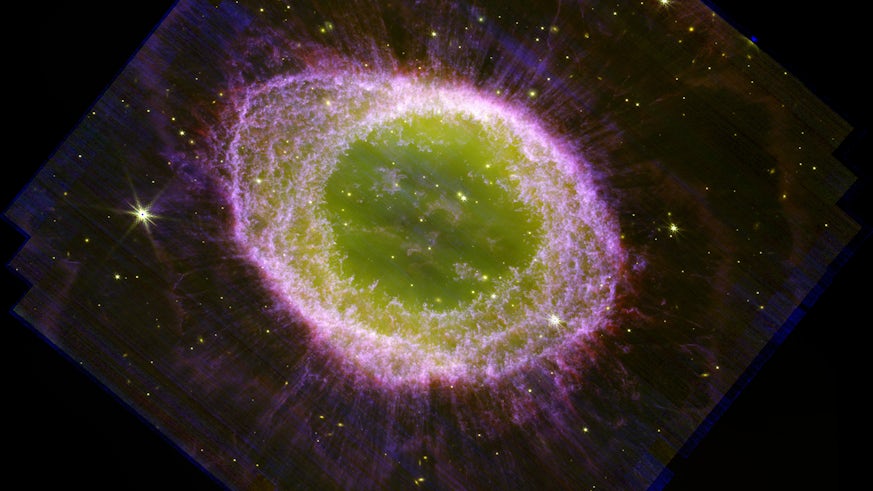Astronomers spy structures that “no previous telescope could detect” in new images of dying star
4 August 2023

New images of a dying star at the centre of a well-known planetary nebula 2,600 light years from Earth have revealed structures that no previous telescope could detect, according to an international team of scientists, who released the images on Thursday 3 August 2023.
The team, which includes researchers at Cardiff University’s School of Physics and Astronomy, say the images of the Ring Nebula captured by JWST between July and August 2022 provide never-before-seen detail of its structure.
While the variety of structures and phases revealed in the images share characteristics with other well-studied nebulae, the researchers say the time when planetary nebulae could be modelled as uniform density spheres is long gone.
Dr Roger Wesson, a Research Associate at Cardiff University’s School of Physics and Astronomy who led the analysis, said: “These new images taken with JWST show incredibly complex structures in the form of arcs, spikes, wisps and clumps, all formed as a dying star throws off its outer layers.”

Planetary nebulae such as the Ring form when stars with up to about eight times the mass of our Sun exhaust the hydrogen in their cores and eject their outer layers.
As the source of much of the carbon and nitrogen in the universe, the way in which these stars evolve and die is crucial to understanding the origin of these elements, without which life on Earth could not have developed.
Dr Wesson added: “Planetary nebulae were once thought of as very simple objects, roughly spherical and with a single star at their centre. Hubble showed that they were much more complicated than that, and with these latest images JWST is revealing yet more intricate detail in these objects.”
Launched in December 2021, JWST is an international programme led by NASA with its partners, the European Space Agency and the Canadian Space Agency.
The premier observatory of the next decade, JWST will enable astronomers worldwide to study every phase in the history of our Universe, ranging from the first luminous glows after the Big Bang, to the formation of stellar and planetary systems capable of supporting life on planets like Earth, to the evolution of our own Solar System.

Dr Mikako Matsuura, a Reader at Cardiff University’s School of Physics and Astronomy, said: “JWST’s six-metre diameter telescope is three times larger than Hubble’s and also operates two infrared cameras, which can detect longer wavelengths than are visible to the human eye or indeed Hubble.
“These telescope and infrared detection innovations mean many of the Ring’s details revealed in these latest JWST images were not previously visible to astronomers.
“Where before we saw only a ring, we now know it is filled with 20,000 globules. And, for the first time, we can also see beyond the ring which extends with faint spikes and arcs, shaping a petal-like structure resembling a flower.”




